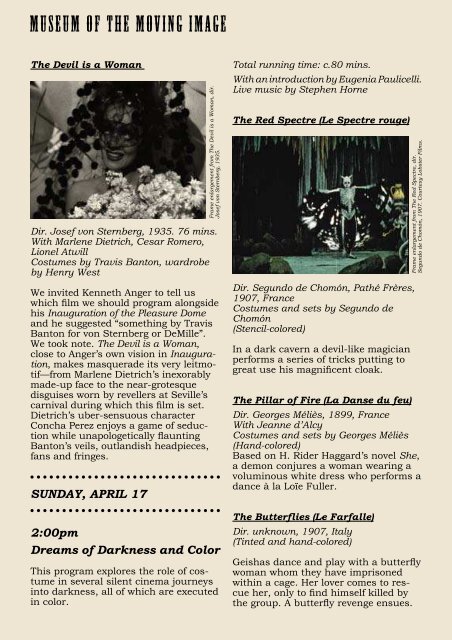Download the full program as PDF - Fashion Film Festival
Download the full program as PDF - Fashion Film Festival
Download the full program as PDF - Fashion Film Festival
You also want an ePaper? Increase the reach of your titles
YUMPU automatically turns print PDFs into web optimized ePapers that Google loves.
MUSEUM OF THE MOVING IMAGE<br />
<strong>the</strong> Devil is a Woman<br />
Dir. Josef von Sternberg, 1935. 76 mins.<br />
With Marlene Dietrich, Cesar Romero,<br />
Lionel Atwill<br />
Costumes by Travis Banton, wardrobe<br />
by Henry West<br />
We invited Kenneth Anger to tell us<br />
which film we should <strong>program</strong> alongside<br />
his Inauguration of <strong>the</strong> Ple<strong>as</strong>ure Dome<br />
and he suggested “something by Travis<br />
Banton for von Sternberg or DeMille”.<br />
We took note. The Devil is a Woman,<br />
close to Anger’s own vision in Inauguration,<br />
makes m<strong>as</strong>querade its very leitmotif—from<br />
Marlene Dietrich’s inexorably<br />
made-up face to <strong>the</strong> near-grotesque<br />
disguises worn by revellers at Seville’s<br />
carnival during which this film is set.<br />
Dietrich’s uber-sensuous character<br />
Concha Perez enjoys a game of seduction<br />
while unapologetically flaunting<br />
Banton’s veils, outlandish headpieces,<br />
fans and fringes.<br />
sunDAY, April 17<br />
Frame enlargement from The Devil is a Woman, dir.<br />
Josef von Sternberg, 1935.<br />
2:00pm<br />
Dreams of Darkness and color<br />
This <strong>program</strong> explores <strong>the</strong> role of costume<br />
in several silent cinema journeys<br />
into darkness, all of which are executed<br />
in color.<br />
Total running time: c.80 mins.<br />
With an introduction by Eugenia Paulicelli.<br />
Live music by Stephen Horne<br />
<strong>the</strong> red spectre (le spectre rouge)<br />
Dir. Segundo de Chomón, Pathé Frères,<br />
1907, France<br />
Costumes and sets by Segundo de<br />
Chomón<br />
(Stencil-colored)<br />
In a dark cavern a devil-like magician<br />
performs a series of tricks putting to<br />
great use his magnificent cloak.<br />
<strong>the</strong> pillar of Fire (la Danse du feu)<br />
Dir. Georges Méliès, 1899, France<br />
With Jeanne d’Alcy<br />
Costumes and sets by Georges Méliès<br />
(Hand-colored)<br />
B<strong>as</strong>ed on H. Rider Haggard’s novel She,<br />
a demon conjures a woman wearing a<br />
voluminous white dress who performs a<br />
dance à la Loïe Fuller.<br />
The Butterflies (Le Farfalle)<br />
Dir. unknown, 1907, Italy<br />
(Tinted and hand-colored)<br />
Frame enlargement from The Red Spectre, dir.<br />
Segundo de Chomόn, 1907. Courtesy Lobster <strong>Film</strong>s.<br />
Geish<strong>as</strong> dance and play with a butterfly<br />
woman whom <strong>the</strong>y have imprisoned<br />
within a cage. Her lover comes to rescue<br />
her, only to find himself killed by<br />
<strong>the</strong> group. A butterfly revenge ensues.<br />
rapsodia satanica<br />
Dir. Nino Oxilia, 1915, Italy<br />
With Lyda Borelli, Andrea Habay, Ugo<br />
Bazzini<br />
Alba’s gowns by Mariano Fortuny<br />
(Tinted and stencil-colored)<br />
A prime example of <strong>the</strong> diva genre, Rapsodia<br />
Satanica is a m<strong>as</strong>terpiece of silent<br />
Italian cinema. It features Lyda Borelli<br />
<strong>as</strong> Alba d’Oltrevita in a Faustian tale of<br />
a woman’s search for eternal youth and<br />
worldly ple<strong>as</strong>ures. The most persistent<br />
<strong>the</strong>mes punctuating <strong>the</strong> film are Alba’s<br />
narcissism and her manipulation of<br />
a thin, diaphanous veil in scenes of<br />
seduction, reflection and melancholy.<br />
Sensuous, <strong>the</strong> veil may evoke <strong>the</strong> craze<br />
for exotic dances that swept European<br />
and American stage and screen around<br />
<strong>the</strong> turn of <strong>the</strong> century but in Alba’s<br />
hands it is more introspective and<br />
eerie than seductive. It <strong>as</strong>sumes a life<br />
of its own <strong>as</strong> it is moulded and layered<br />
over her face and body, producing an<br />
e<strong>the</strong>real, phant<strong>as</strong>mic effect made even<br />
more striking by <strong>the</strong> use of color. Alba’s<br />
nemesis, <strong>the</strong> omnipresent devil, also<br />
operates his vampire-style cloak to<br />
great effect.<br />
With grateful thanks to <strong>the</strong> Italian Cultural<br />
Institute who have supported this<br />
screening on <strong>the</strong> occ<strong>as</strong>ion of celebrating<br />
<strong>the</strong> 150th Anniversary of <strong>the</strong> unification<br />
of Italy.<br />
Frame enlargement from Rapsodia Satanica, dir. Nino Oxilia, 1915/1917. Courtesy EYE <strong>Film</strong> Institute Ne<strong>the</strong>rlands.


